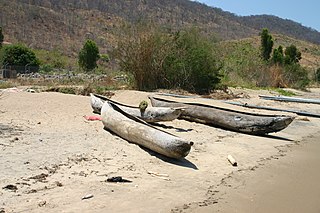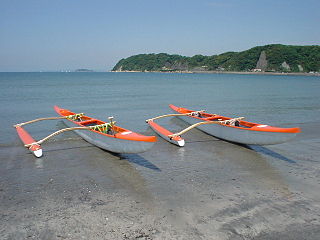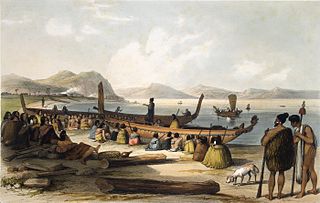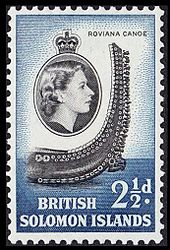
A dugout canoe or simply dugout is a boat made from a hollowed-out tree. Other names for this type of boat are logboat and monoxylon. Monoxylon (μονόξυλον) is Greek – mono- (single) + ξύλον xylon (tree) – and is mostly used in classic Greek texts. In German, they are called Einbaum. Some, but not all, pirogues are also constructed in this manner.

New Georgia, with an area of 2,037 km2 (786 sq mi), is the largest of the islands in Western Province, Solomon Islands, and the 200th-largest island in the world.

Outrigger boats are various watercraft featuring one or more lateral support floats known as outriggers, which are fastened to one or both sides of the main hull. They can range from small dugout canoes to large plank-built vessels. Outrigger boats can also vary in their configuration, from the ancestral double-hull configuration (catamarans), to single-outrigger vessels prevalent in the Pacific Islands and Madagascar, to the double-outrigger vessels (trimarans) prevalent in Island Southeast Asia. They are traditionally fitted with Austronesian sails, like the crab claw sails and tanja sails, but in modern times are often fitted with petrol engines.

Waka are Māori watercraft, usually canoes ranging in size from small, unornamented canoes used for fishing and river travel to large, decorated war canoes up to 40 metres (130 ft) long.

A tepukei, tepuke or TePuke is a Polynesian boat type, characterized by its elaborate decking, its submerged hulls and symmetrical "crab claw" sail slender foil or radically extended tips claw sail. Tepukei boats are produced primarily by the Polynesian-speaking inhabitants of Taumako, and have been occasionally borrowed by other Polynesian and Melanesian societies.
Canoe sailing refers to the practice of fitting an Austronesian outrigger or Western canoe with sails.

A Bisj, mbis or Bis pole is a ritual artifact created and used by the Asmat people of south-western New Guinea, Indonesia. Bisj poles can be erected as an act of revenge, to pay homage to the ancestors, to calm the spirits of the deceased and to bring harmony and spiritual strength to the community. Bisj poles are a type of wooden ancestor pole among the Asmat of the province of South Papua, Indonesia. Figures of the dead are stacked along the pole, and a phallic symbol of fertility and power is included. The poles were traditionally carved to accompany the feast after a headhunting raid, and although headhunting is no longer practiced, the bisj tradition continues to the present time as a customary practice to honor deceased members of a village.

The vinta is a traditional outrigger boat from the Philippine island of Mindanao. The boats are made by Sama-Bajau, Tausug and Yakan peoples living in the Sulu Archipelago, Zamboanga peninsula, and southern Mindanao. Vinta are characterized by their colorful rectangular lug sails (bukay) and bifurcated prows and sterns, which resemble the gaping mouth of a crocodile. Vinta are used as fishing vessels, cargo ships, and houseboats. Smaller undecorated versions of the vinta used for fishing are known as tondaan.

Drua, also known as na drua, n'drua, ndrua or waqa tabu, is a double-hull sailing boat that originated in the south-western Pacific islands. Druas do not tack but rather shunt. Both ends of each hull are identical, but the hulls are of different sizes and the smaller one is always sailed to windward. The main differences, compared to proas, are that the hulls have a symmetric U-form profile, and a second hull is used instead of an outrigger. When a float (cama) is used in place of the smaller hull, the craft is called a camakau.
The Fijian double canoe was the largest and finest sea-going vessel ever designed and built by natives of Oceania before contact with Europeans.

Traditionally, many different kinds of boats have been used as fishing boats to catch fish in the sea, or on a lake or river. Even today, many traditional fishing boats are still in use. According to the United Nations Food and Agriculture Organization (FAO), at the end of 2004, the world fishing fleet consisted of about 4 million vessels, of which 2.7 million were undecked (open) boats. While nearly all decked vessels were mechanised, only one-third of the undecked fishing boats were powered, usually with outboard engines. The remaining 1.8 million boats were traditional craft of various types, operated by sail and oars.

Camakau are a traditional watercraft of Fiji. Part of the broader Austronesian tradition, they are similar to catamarans, outrigger canoes, or smaller versions of the drua, but are larger than a takia. These vessels were built primarily for the purposes of travelling between islands and for trade. These canoes are single hulled, with an outrigger and a cama, a float, with both ends of the hull being symmetrical. They were very large, capable of travelling open ocean, and have been recorded as being up to 70 ft in length.

Wa are traditional sailing outrigger canoes of the Caroline Islands, Palau, and Yap. They have a single outrigger. They are similar to the sakman of the Northern Marianas.

Karakoa were large outrigger warships from the Philippines. They were used by native Filipinos, notably the Kapampangans and the Visayans, during seasonal sea raids. Karakoa were distinct from other traditional Philippine sailing vessels in that they were equipped with platforms for transporting warriors and for fighting at sea. During peacetime, they were also used as trading ships. Large karakoa, which could carry hundreds of rowers and warriors, were known as joangas by the Spanish.

Bangka are various native watercraft of the Philippines. It originally referred to small double-outrigger dugout canoes used in rivers and shallow coastal waters, but since the 18th century, it has expanded to include larger lashed-lug ships, with or without outriggers. Though the term used is the same throughout the Philippines, "bangka" can refer to a very diverse range of boats specific to different regions. Bangka was also spelled as banca, panca, or panga in Spanish. It is also known archaically as sakayan.
The Kalikoqu are an ethnic Melanesian tribe who are concentrated in the New Georgia island of the Solomon Islands. Prior to European colonization, they resided in the eastern side of the western Roviana lagoon and established the concept of the right to property by interlinking it with marriage. Before, during and after the British Empire's establishment of the Solomon Islands Protectorate in the late Victorian era, the Kalikoqu were greatly expanded by neighboring Melanesian tribes immigrating to the Solomon Islands interior.

Sakman, better known in western sources as flying proas, are traditional sailing outrigger boats of the Chamorro people of the Northern Marianas. They are characterized by a single outrigger and a crab claw sail. They are the largest native sailing ships (ladjak) of the Chamorro people. Followed by the slightly smaller lelek and the medium-sized duding. They are similar to other traditional sailing ships of Micronesia, like the wa, baurua, and the walap. These ships were once used for trade and transportation between islands.
Lisi is a type of plank boat from the Solomon Islands. It is crescent-shaped and is similar in appearance to the tomako war canoes, but differs in that the topmost strakes of the lisi have a gap in the middle. Lisi are also usually proportionally broader and less ornamented than the tomako. They are used for fishing and transport rather than for raiding. Lisi can vary in size from small canoes to large ships used for trade. The largest types of lisi are known as solima, which can carry 50 people and is used for long sea voyages. There are two general types of lisi, the ordinary trading lisi is known as the "lisi nume." An ornate lisi with inlaid shell decorations used for transporting village chiefs in diplomatic missions is known as the "la'o." Voyages of lisi to other islands usually required a ritual human sacrifice on the return trip known as siki po'upo'u.

Binabina or biabina is a type of plank boat from the Solomon Islands. It differs from the similar tomako and lisi in that only the stern is upturned, while the bow is horizontal.
























